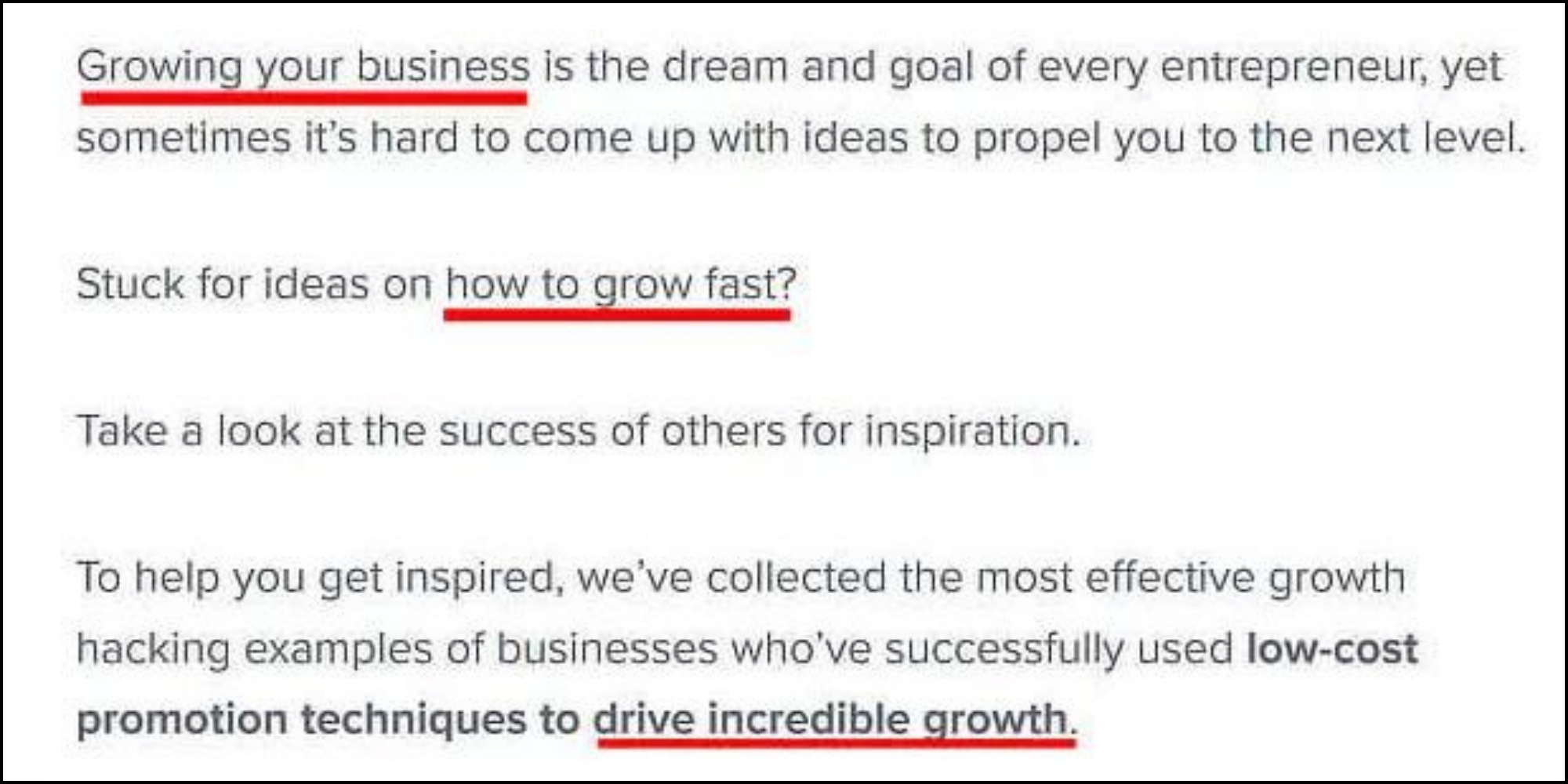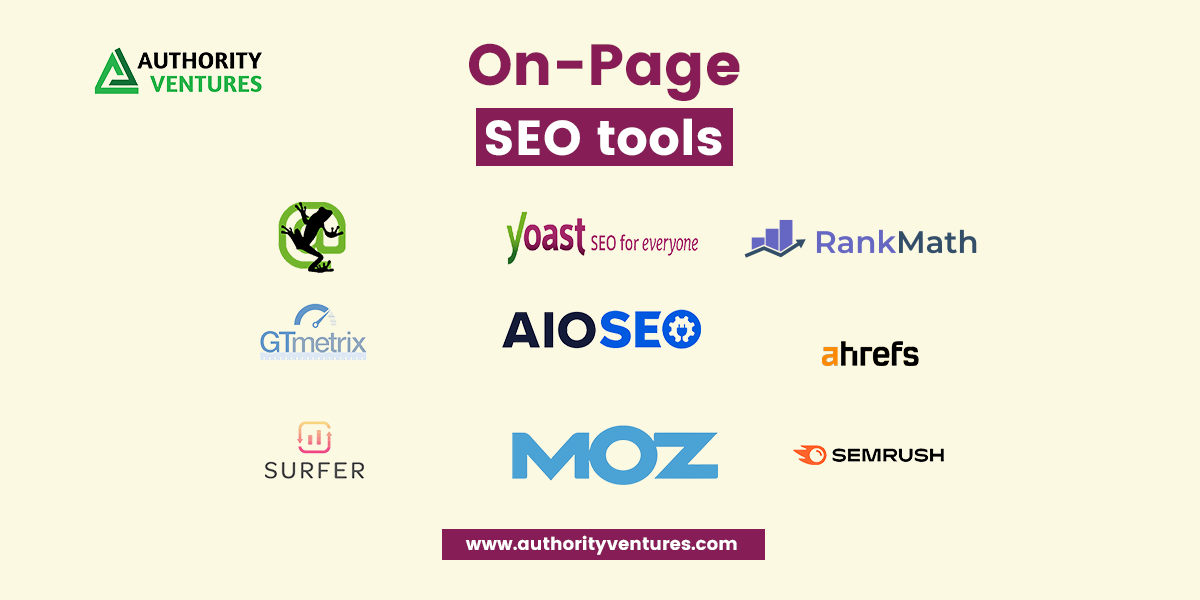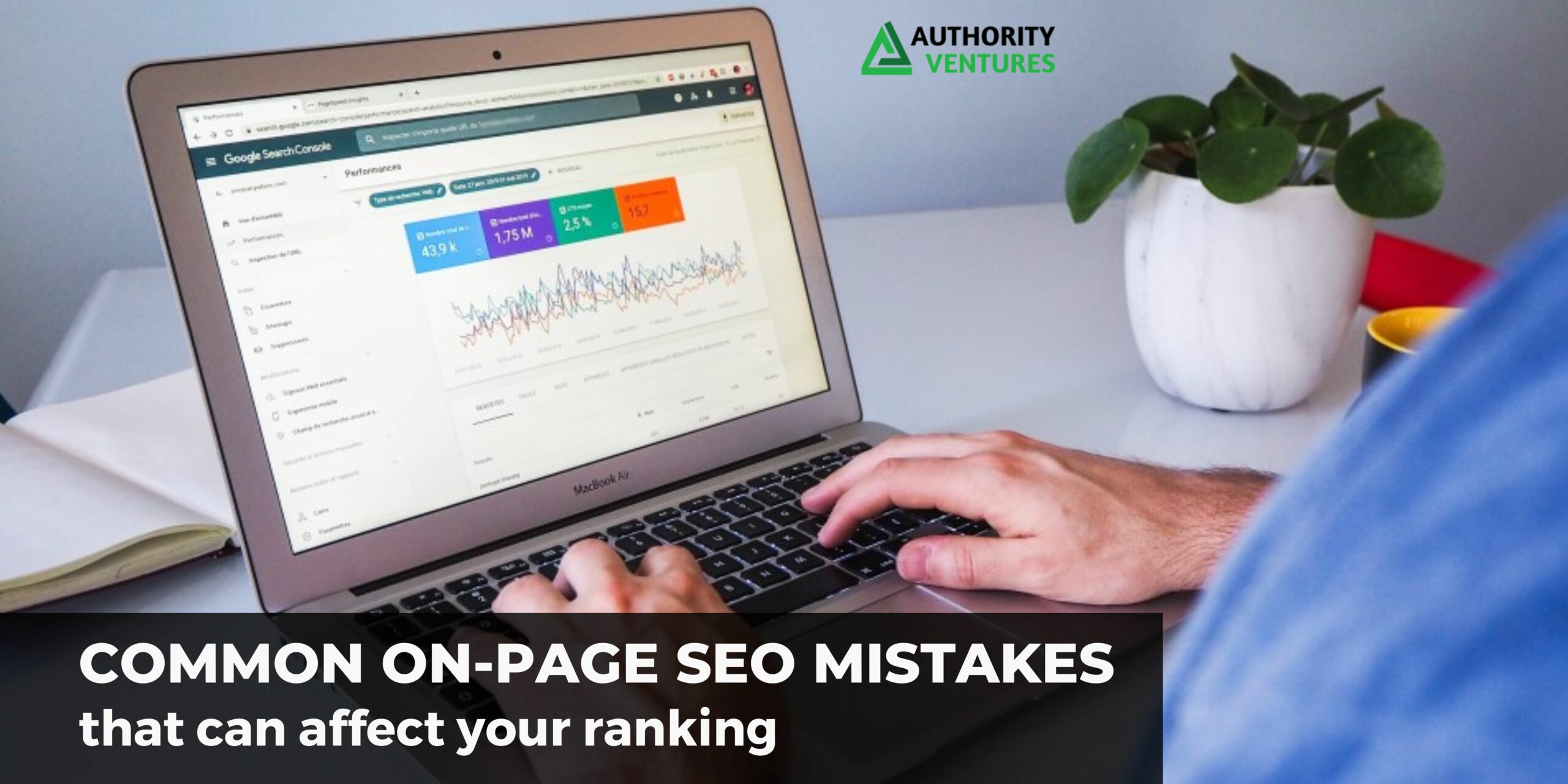Have you ever wondered why some websites rank higher on search engine results pages while others struggle to gain visibility? The magic lies in on-page SEO. By understanding its importance and mastering its essential elements, you can give your website the competitive edge it needs to rise above the rest. So let’s dive into this comprehensive guide, exploring the world of on-page SEO and uncovering the techniques that can propel your website to the top.
- On-page SEO is an important part of any website’s overall SEO strategy, involving optimising content and structure to improve search engine visibility.
- Essential On-Page SEO factors include keyword research, tags optimization, meta description, URL structure optimization and enhancing user experience (UX).
- Common mistakes to avoid are keyword stuffing, duplicate content & poor site architecture for successful on-page results.
Understanding On-Page SEO: Definition & Importance
On-page SEO involves optimising website content and structure to enhance search engine visibility and draw organic traffic, while off-page SEO focuses on external factors such as backlinks and social signals.
But why is on-page SEO important? Simply put, it’s critical for enhancing search engine rankings and generating organic traffic, making it an essential aspect of any website’s overall SEO strategy.
On-page SEO involves practices such as improving on-page content, title tags, internal links, meta descriptions, and other elements; so is called on-site SEO or on-page SEO. This approach enhances search engine visibility and user experience.
Let’s explore some of the main advantages of on-page SEO. By mastering the art of on-page SEO, you can improve your website’s search engine rankings, attract more relevant traffic, and ultimately achieve your business goals.

Key Components of On-Page SEO
On-page SEO refers to the elements and optimizations directly implemented on individual web pages. Search engine algorithms, especially those of major search engines like Google, are continuously evolving. As of 2023, Google’s ranking algorithms are equipped with advanced technologies like AI, changing the dynamics of on-page SEO.
There are some fundamental on-page optimization techniques that have been essential for a long time and are still relevant in the present. On the other hand, there are advanced SEO factors that are more sophisticated. These cutting-edge strategies have become increasingly important due to changes in search engine algorithms and user behaviour.
It is equally important to optimise for both the traditional and advanced SEO factors to stay at the forefront of SEO.

Is On-Page SEO Worth It After AI Takeover?
To understand the worth of on-page SEO in 2023, we must keep track of how search engines have evolved and which direction they are heading in. Interestingly, if you take a time machine and travel back some 25 years, the meaning of on-page SEO and the practices would be completely different.
1990’s: Keyword Stuffing
On-page SEO has evolved a lot since the 1990s. Back then, in the 1990s, optimization factors were limited to: writing enough text, writing relevant content, usage of HTML tags and internal and external linking and, that’s all.
In that era, you only had to be up for a “keyword war” with your competitors; if they mentioned their keywords 50 times, you could outrank them by adding the keywords 70 times.
Although it worked for the optimizers, the user experience was severely affected. Imagine reading a meta description that has the target keyword more than once.

2012: Keyword Density
In the past, keyword density played a significant role in SEO. Content creators had to follow the rule of placing target keywords in specific areas of a paragraph. This is a classic example of what keyword density would look like in a 1000-word paragraph.
Using keywords is still relevant in 2023, but experts predict that it may become obsolete in the future. A future without the need for keywords is anticipated.
2023: Keyword Variation
Cut to 2023, the customer’s demands have increased and changed, and the SEO scenario is entirely different. Today’s search engines focus more on being a good assistant to the users than just text and images.
The introduction of AI, NLP, ML and many other cutting-edge technologies in search engine optimization shows that Google now wants to connect with users in a more personalized manner, serving more quality. So it is a no-brainer that in order to improve the user experience, Google ranks content based on relevance.
The good news is that when search platforms are more oriented to provide quality results, you, too, can rank and take your business to the next level. The only condition is knowledge, dedication, and consistency.

How is AI impacting On-Page SEO?
Artificial intelligence is now overlapping with on-page SEO continuously; the search engines such as Google or Bing have become the early users of AI for user’s advantage.
Broadly, search engines have been working on advancements such as NLP, BERT, and many others for analysing and recommending the best content for the users.
So much so that SEO experts are using AI to improve their on-page SEO methods and to ensure compliance with Google’s best practices. AI tools simplify tasks like keyword research and content outlining.
Let’s have a look at a few applications of AI in on-page SEO.
AI-driven Content: The introduction of AI in content optimization is nothing new; plugins such as Yoast and RankMath have been in trend for many years to make their content crawler-friendly.
Additionally, tools such as ChatGPT are now helping the creators in content composition and saving them a tremendous amount of time and effort in extensive tasks such as outline creation, research, and providing real-time feedback based on the tone, keywords, page title, and even writing SEO-friendly meta descriptions within the character limit.
AI-based analytics: Many power-packed AI tools make on-page SEO much more manageable for SEO experts. For instance, tools like Tableau and Polymer SEO communicate with users and provide them with more profound insights about the customer’s data, campaign, and success rate.
These tools help forecast future trends, user behavior, and search engine algorithm updates. Based on this data, decision-making has been made even more accessible than ever.
AI-based coding and recommendations: Besides providing the soundest meta description, AI tools are also prevalent in helping coders create SEO-friendly websites.
As a part of AI’s contribution to website design, coders can now create customised code from various AI assistants such as Amazon CodeWhisperer, ChatGPT, Perplexity AI, and many more.
Many AI-based plugins add value to your website and ensure that your website is SEO-friendly.
Automated optimization
Artificial intelligence-based optimization has been practiced for the last few years. For instance, AI-based algorithms can spot optimization errors, help you, and even provide valuable feedback for improving it.
The tools like Surfer SEO are becoming popular as they provide real-time insights and identify content gaps.
It is crucial to include all critical keywords, and if any are missed, the tool suggests variations to add them to different sentences with different uses.
AI for search results: Google’s algorithms use your location, past search history, and search settings to provide you with the most relevant and useful search results.
For example, if you search for “football” in the US, you are more likely to see search results for American football.
However, if you search for the same keyword from India or any other country where “football” refers to a different game, you will see search results relevant to your location.
The Future Of On-Page SEO As We Know It

In the forthcoming years, on-page SEO will remain essential for attaining good rankings and driving organic traffic. However, the dynamics of the on-site optimization may have some significant shifts.
Some industry experts predict that On-Page SEO may move away from keywords as searchers get smarter in the future.
In addition, they also anticipate that a page can rank for a “keyword” even if it does not have the target keyword on the page because the context will matter the most. Therefore, content writers prioritizing Search Intent, Context, and Topical Authority can look forward to a promising future. Let’s see what will be the future of on-page optimization.
User-centric optimization
It’s obvious to predict that search engines will be highly user-centric. I mean that even the slightest inconvenience to the user may let you face the consequences.
In the next few years, the SEOs and content creators will have to entertain users with even more valuable content and keep their page’s performance at optimum. So, be it the site speed or the search intent, title tags or even the page title, everything must be on the mark.
Mobile-first practice
Even though mobile friendliness is still prevalent, the coming years will focus more on the mobile-first approach. The dominance of mobile devices is likely to increase at a good pace.
Hence, the SEO experts, web developers, and web designers will have to brace themselves for the best ways to beat their competitors in providing a better UX on the mobile phone.
In addition to this, the creation of the best mobile-friendly theme and templates will likely increase.
Prevalence of Voice Search
It is predicted that voice search will prevail in the coming years as users are increasingly becoming reliant on the assistants such as Alexa, Siri and Google Assistants. It means the content writers have a lot of homework to do in creating content that meets the voice search standards.
The voice-search-optimized content will have more chances to rank for the voice query.
When it comes to creating content, users like pieces that are both concise and conversational in nature. Everybody prefers content that is precise and has a more conversational tone so that every user can engage with the content quickly and get answers that satisfy the intent of their search.
First-Hand experience
Even now and in the forthcoming years, Google will evaluate your content by E-E-A-T (Expertise, Experience, Authority and Trustworthiness), a quality evaluator checking your content based on the author’s professional expertise, personal experience, and credibility.
Understand that it is an attempt by Google to uplift the content standards and provide higher value to visitors.
For instance, when you search for a health condition or even make a financial decision, expertise counts the most, and that’s what it will do. So if you take search engine rankings quite seriously, it is highly suggested to become familiar with the E-E-A-T.
Speakable Schema Markup
In the near future, Speakable Schema Markup will be necessary because of the popularity of voice search. Speakable Schema Markup helps identify the best-suited parts of a page for text-to-speech, making it easier for users to consume content.
If you want to stay ahead of the game and keep up with the rise of voice-activated devices, this is worth your time.
How Often Should You Audit And Update Your On-Page SEO
Regular auditing can help you establish baseline metrics, track changes in SEO, improve the site speed, identify the factors that affect your overall user experience and many more. As an on-page SEO expert, I take audits as an opportunity to fix errors and ensure that everything on a page is up to the mark.
However, the frequency of auditing varies based on the complexity and size of your website. A smaller website may not need as extensive and hard auditing as the bigger ones.
To put it simply, it is essential to audit the bigger and transaction-based websites with more than 50 pages more frequently.
It would be smart to classify your audits as mini-audits and major audits. You must run a series of mini-audits regularly, but surely conduct a major On-page audit every 3 to 6 months to ensure optimal performance.
Additionally, it is extremely important to stay up-to-date with algorithm updates and adjust your SEO strategy accordingly.
On-Page SEO Tools
Luckily, there are several on-page tools available that can assist you with a high degree of accuracy. To streamline your work and achieve on-page SEO success, consider utilising the following tools.
- Yoast SEO: It helps you optimise your page as per the widely accepted on-page SEO rules as well as assists you in creating SEO-optimised headlines, meta descriptions etc.
- Rank Math: Like Yoast SEO, it helps you optimise your page per SEO standards and allows you to work up to 5 keywords simultaneously.
- All-in-One SEO: This tool offers various SEO features and real-time suggestions to make your page more SEO friendly.
- Screaming Frog: Screaming Frog is a powerful tool that helps you look for duplicate content, find broken links, generate XML sitemaps and much more.
- Moz Pro is a robust tool that helps you conduct audits, keyword research, backlink analysis and rank tracking.
- Surfer SEO: Surfer SEO is an NLP (Natural Language Processing) based tool that assists you with content optimization, competitor research, and backlink analysis.
- Neuron: It is an AI Powered Content optimization tool that optimises your content as per SEO norms and increases your chances of ranking on the SERP.
- Ahrefs and SEMrush: These tools help you conduct keyword research, competitor analysis, search volume, search intent, and more to get ahead in SEO.

Monitoring and Analysing On-Page SEO Performance
Regularly tracking and analysing your on-page SEO efforts is crucial for identifying areas for improvement and ensuring the success of your overall SEO strategy.
Tools like Google Analytics, Google Search Console, and Google Tag Manager can provide valuable insights into your website’s performance, helping you make data-driven decisions to optimise your on-page SEO.
Google Analytics allows you to track various metrics related to user engagement, traffic sources, and content performance. By monitoring these metrics, you can identify trends and patterns in your website’s performance, helping you pinpoint areas that require optimization.
For instance, if you notice that certain pages have high bounce rates or low conversion rates, you may need to revise your content or improve your site’s navigation to better cater to user needs.
Google Search Console, on the other hand, provides detailed information about your website’s search engine visibility and performance. You can use Search Console to monitor your website’s search engine rankings, discover any indexing issues, and identify opportunities for improvement.

Additionally, the Core Web Vitals report in Site Audit can help you evaluate your website’s performance in terms of key user experience metrics such as Largest Contentful Paint (LCP), First Input Delay (FID), and Cumulative Layout Shift (CLS).
Google Tag Manager simplifies tag management and deployment without code editing. It helps track user behaviour, monitor website performance, and optimize engagement and conversions. This tool is set up for tracking tags for on-page SEO elements like page views, clicks, and form submissions.
In addition to having an easy-to-use UI, it is also suitable for smaller teams as it is free of cost and provides practical solutions
By regularly monitoring and analysing your on-page SEO performance, you can make informed decisions to optimise your website, enhance user experience, and drive more organic traffic to your site.
Avoiding Common On-Page SEO Mistakes

It just takes a few wrong moves to fall below Google rankings, as Google’s algorithms have the necessary mathematical and sentimental logic to identify any black-hat tactics and discrepancies.
Ignoring these mistakes can lead to consequences like a fall in SERP positions and even penalties. make sure to steer clear of the following on-page SEO mistakes:
Keyword stuffing: The practice of overusing target keywords within your content in an attempt to manipulate Google ranking factor. As I discussed above, this is now an outdated tactic and can actually harm your website’s search engine visibility, as search engines like Google prefer natural, high-quality content that provides value to users. Instead of stuffing your content with keywords, focus on creating informative, engaging content that naturally incorporates your target keywords.
Duplicate content: Duplicity can also negatively impact your on-page SEO efforts. Search engines may struggle to determine which version of the content to index and rank, potentially leading to lower search engine visibility for your website.
To avoid duplicate content issues, ensure that your content is unique and provides a fresh perspective on the topic. If you have multiple pages with similar content, consider consolidating them into a single, comprehensive page or using canonical tags to indicate the preferred version of the content.
Neglecting Mobile-Friendly Design: Standard website or web page design cannot provide the same experience on every device. Statistically, most users find you on a mobile nowadays. A poorly designed website on mobile can be off-putting for users.
It can even account for a high bounce rate. In the end, with a less mobile-friendly design, you will end up losing both customers and ranking.
Ignoring User Experience Factors: An on-page SEO strategy must be more user-centric to reap good results. Understand that the users are the ultimate masters of Google.
If, in any case, you don’t meet the user’s expectations in terms of information, visuals, and performance, you are likely to see a significant decline in your rankings.
To ensure your website provides the user experience of the highest order, stay tuned with Google’s algorithm’s updates and resolve the discrepancies in your website.
Using Thin or Low-Quality Content: Thin content refers to content that provides little value to the audience and doesn’t satisfy its users because of its quality. It is highly suggested to refrain from using thin and low-quality content.
Consider that the authority of the pages with such content is more likely to get affected.
Be it the overall content length or the meta descriptions, you must ensure that you have done multiple revisions of the content and check if the content is written in-depth, satisfies the search intent, and has more than the recommended words.
Poor site architecture is another common on-page SEO mistake that can hinder your website’s performance. A poorly structured website can make it difficult for users to navigate and find the information they need, leading to a negative user experience and lower search engine rankings.
To improve your site’s architecture, focus on designing a logical and user-friendly structure that enables users and search engines to easily navigate your website.
By avoiding these common on-page SEO mistakes and following the best practices shared, you can enhance your website’s search engine visibility, user experience, and overall performance.
Tracking and Measuring On-Page SEO Success
Utilising Web Analytics Tools
Your on-page SEO strategy has to keep changing and, those changes will be based on chunks of data such as bounce rate, dwell time, CTR, average session time, and much more. To analyse what these numbers mean, web analytic tools can help you. It would be best if you got a good grip on some web analytics tools such as:
- Semrush
- Chartbeat
- Kissmetrics
- Adobe Analytics
Setting Key Performance Indicators (KPIs)
Setting up Key Performance Indicators helps you easily measure and monitor allegiance with on-page SEO factors. Some KPIs may vary from one industry to another; for instance, only some expect the same results from on-page.
The purpose of on-page SEO could be anything ranging from brand awareness to lead generation. However, the most common KPIs that determine on-page optimization success are
- Customer lifetime value
- Organic traffic
- CTR
- Bounce rate
- Dwell time
- PPS (Pages per session)
- Leads and conversion
Monitoring and Improving Rankings and Traffic
After you equip your page with all on-page SEO elements, you enter the next stage: monitoring. Keeping track of your on-page SEO results is crucial as it tells you how well you have done and what you lack from achieving outstanding results.
Luckily, you can automate the monitoring with some reliable tools and extensions, such as
- Semrush
- Sheet Consolidator
- Lipperhey
- SEO PowerSuite
- Google Analytics
- Dareboost
- Rankmath
- HubSpot
- SEOquake
- Sheets For Marketers
Summary
In conclusion, mastering the art of on-page SEO is essential for ensuring your website’s search engine visibility, user experience, and overall performance.
By understanding the importance of on-page SEO and implementing the techniques outlined in this article, you can optimize your website’s content, structure, and user experience, ultimately driving more traffic and achieving your business goals.
In the same light, one must also pay heed to common Search Engine Optimization mistakes such as over-optimization and keyword stuffing and refrain from committing those errors. In addition, it is quite important to acknowledge that search engines will become even more user-centric in the coming years, and AI will be prevalent.
Hence, one with growth in mind must keep in touch with regular updates as well as become flexible to create different strategies accordingly. Moreover, SEOs need to adapt to the new AI tools and technologies.
Frequently Asked Questions
On-page SEO is the process of optimising your content and HTML elements on a website or a web page in order to improve its ranking in search engine results pages. It includes measures such as improving your text, meta descriptions and title tags as per the standards of Google’s ranking algorithms.
On-page SEO involves optimizing elements within a website to help search engines understand the content better, while off-page SEO refers to tactics outside of the website, like backlinks and mentions to generate exposure and build trust. It is imperative to understand that a successful Search Engine Optimization strategy is a perfect blend of both on-page and off-page SEO.
Our on-page SEO strategy focuses on optimising web page content to improve search engine rankings and earn organic traffic. This includes optimising titles, content, internal links, URLs, and HTML tags.
Additionally, we make sure that you publish relevant, high-quality content that aligns with search intent to maximize the success of on-page SEO.
To improve readability, use clear headings and subheadings, page title, bullet points to make content scannable, and add a professional tone in your language.
Optimising for voice search, targeting featured snippets, and implementing schema markup are all great ways to start advancing your on-page SEO.
Internal links connect pages within a site, while external links lead to other sites. Internal links organize the site and distribute link equity, while external links boost credibility by linking to pages with higher domain authority.
Although meta description is not a direct on-page ranking factor, it is still important because of the value it can provide to visitors. It is essential to avoid writing misleading or low-value meta description, or a meta description without relevant keywords.
When optimizing for on-page SEO, it’s important to consider factors like content quality, page speed, page structure, internal linking, and keyword usage.
Heading tags are incredibly crucial for on-page SEO. It is essential to understand that headings structure your content better and let search engines, as well as visitors, comprehend the hierarchy of your page in a better way.



